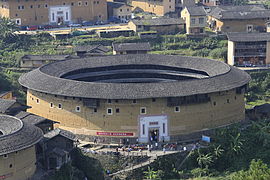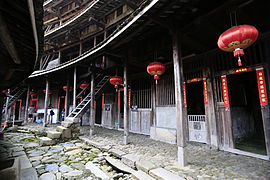Chuxi Tulou cluster

The Chuxi Tulou cluster (Chinese: 初溪土楼群; pinyin: Chūxī tǔlóu qún) is a group of earthen structures or "tulou" dating to the Ming dynasty (1368–1644).[1] The group provides a tourist attraction in the town of Xiayang (下洋镇), Yongding County, Longyan, Fujian Province, China.
History
[edit]Chuxi Tulou cluster is a Hakka village inhabited by Xu (徐) clan, who settled down in the 14th century.[2] The first tulou was Heqing Lou (simplified Chinese: 和庆楼; traditional Chinese: 和慶樓), which was the ancestry tulou of the village. After that, all tulous built in the village were named with a Chinese character qing (simplified Chinese: 庆; traditional Chinese: 慶), with a wish of having a flourishing population.[3] Chuxi tulou group was designated as UNESCO World Heritage site as part of Fujian Tulou in 2008.
Structures
[edit]A total of 36 tulous are conserved in Chuxi village.[4] The largest and also the oldest in the cluster is Jiqing Lou (simplified Chinese: 集庆楼; traditional Chinese: 集慶樓), built in 1419 during the reign of the Yongle Emperor of the Ming dynasty. It consists of two concentric rings, the outer ring building is four stories tall, with 53 rooms on each level. The outer ring contains 72 stairs split into 72 units interfacing each other. The second ring is a one-story building.[5]
Famous tulou
[edit]Ten tulous were listed in the UNESCO World Heritage site.
| Name | Image | Year | Area [m2] | Shape | Description |
|---|---|---|---|---|---|
| Jiqing Lou (simplified Chinese: 集庆楼; traditional Chinese: 集慶樓) | 
|
1419 | 2826 | Circular | |
| Shengqing Lou (simplified Chinese: 绳庆楼; traditional Chinese: 繩慶樓) | 
|
1799 | 1482 | Rectangula | |
| Yuqing Lou (simplified Chinese: 余庆楼; traditional Chinese: 餘慶樓) | 
|
1729 | 1256 | Circular | |
| Huaqing Lou (simplified Chinese: 华庆楼; traditional Chinese: 華慶樓) | 1829 | 480 | Rectangula | ||
| Gengqing Lou (simplified Chinese: 庚庆楼; traditional Chinese: 庚慶樓) | 
|
1840 | 660 | Circular | |
| Fuqing Lou (simplified Chinese: 福庆楼; traditional Chinese: 福慶樓) | 1849 | 660 | Oval | ||
| Xiqing Lou (simplified Chinese: 锡庆楼; traditional Chinese: 錫慶樓) | 1849 | 400 | Rectangula | ||
| Fanqing Lou (simplified Chinese: 藩庆楼; traditional Chinese: 藩慶樓) | 
|
1949 | Rectangula | ||
| Gongqing Lou (simplified Chinese: 共庆楼; traditional Chinese: 共慶樓) | 1949 | 3500 | Hexagonal | ||
| Shanqing Lou (simplified Chinese: 善庆楼; traditional Chinese: 善慶樓) | 1979 | 1200 | Circular |
Trivia
[edit]The CIA once believed that Chuxi Tulou were missile bases due to their size and shape in the 1960s.[6]
Gallery
[edit]References
[edit]- ^ "Seventh instalment of protection for provincial cultural relics". People's Government of Fujian Province. 16 November 2009. Archived from the original on 24 December 2013. Retrieved 23 February 2014. (in Chinese)
- ^ "初溪的美妙之旅". People's Government of Fujian Province. 4 December 2014. Retrieved 31 May 2017.[permanent dead link] (in Chinese)
- ^ "永定土楼代表:初溪土楼群". Fujian Southeast Net. 31 May 2014. Retrieved 31 May 2017. (in Chinese)
- ^ "八闽千姿:总书记春节看土楼 客家文化受瞩目". Netease. 18 February 2010. Retrieved 31 May 2017. (in Chinese)
- ^ "永定初溪集庆楼 展示客家民俗的窗口". People's Government of Fujian Province. 2 May 2013. Retrieved 31 May 2017.[permanent dead link] (in Chinese)
- ^ "土楼之乡 发力围屋深度游". southcn.com. 14 June 2012. Retrieved 2 June 2017. (in Chinese)








